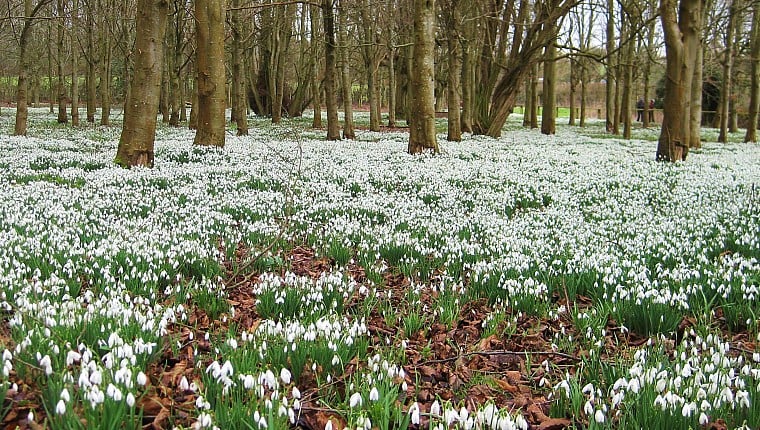Spotting snowdrop species

Across Britain, snowdrops will be piercing through the frosty soil, bringing the first sign of spring to our gardens from early January.
In celebration of the snowdrops, National Garden Scheme volunteer and galanthophile, Myra, explains how to identify some of the snowdrops which can be spotted across over 100 National Garden Scheme gardens open in January and February 2025.
With tiny, white, often scented flowers, snowdrops appear when there are few other flowers in bloom. They have the power to lift the spirits during the dull days of winter. And though they look delicate, snowdrops can push through layers of snow – giving them the name ‘snow piercer.’
Snowdrops look magical in huge white drifts, naturalised in deciduous woodland, where they happily multiply. Being tiny plants, they can easily be grown in the smallest of gardens, making it possible to collect just a few different varieties.
The National Garden Scheme’s Snowdrop Festival gives you the opportunity to enjoy such stunning spectacles, but also to look out for some of the more unusual species. With the number of named snowdrops now estimated to be in the thousands, there is plenty to see!
Galanthus is the family name for all snowdrops. There are over 19 wild species and within this family there are a few significant snowdrops. The most important are Galanthus nivalis, Galanthus elwesii and Galanthus plicatus. Together they are the ancestors of almost all known snowdrops.

Galanthus ‘Blewbury Tart’
Galanthus nivalis
Galanthus nivalis, meaning ‘milk flower of the snow’, is the most common snowdrop to look out for in National Garden Scheme gardens. This snowdrop is small and has three white outer petals, and three inner ones that overlap slightly. These inner petals each have a green marking in the shape of an inverted V.
Galanthus elwesii
Henry John Elwes was a Victorian traveller and plant hunter. Travelling in Turkey he found the giant snowdrop, Galanthus elwesii, which is now named after him. Elwes moved to Colesbourne Park in Gloucestershire in 1891 and went on to build one of the largest collections of bulbs in the world. This species has broad grey leaves and large flowers, where the inner petals display two blotches, usually one above the other.
Possibly due to the length of time it has been cultivated, Galanthus elwesii is probably the most common species in cultivation after Galanthus nivalis, and wild harvesting of this beautiful snowdrop is now carefully controlled!
Galanthus plicatus
Often known as the ‘pleated snowdrop’, Galanthus plicatus has a distinctive folding of its broad dark green leaves and is easily hybridizes with G.nivalis and G.elwesii producing some of the finest snowdrops in cultivation.
One such snowdrop is Galanthus plicatus ‘Trym, found in Westbury on Trym near Bristol. The outer segments of the flower are a similar size to the inner ones and kick outwards as the flower ages. These petals are distinctly marked with a plump heart shape.
One of the earliest and a very beautiful, double snowdrop to look out for when visiting gardens, is Galanthus ‘Lady Beatrix Stanley.’ The inner petals are wide but tight, with small markings on the edge. The outer petals long and narrow.
So wrap up warm, join other snowdrop lovers and explore gardens opening for the National Garden Scheme You never know, you may spot a new, exciting variety!
CLICK HERE for 2025 openings in January and February


















